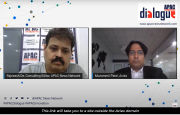The writing on the wall is clear. The new kid on the block is no-code platforms and it is here to stay. As businesses grapple and work towards transforming themselves into a digital first enterprise, technology evangelists tick off the benefits of working with no-code platforms. Foremost among these benefits is the speed and agility that no-code platforms bring in transforming business processes into digital applications.
But speed and agility aren’t only about the time taken to develop the application. A no-code approach also needs to encompass the deployment time of the application covering the time and effort taken to get the application into the production and meet the legacy security and audit requirements of the organisation. Given the accelerated change management and enhancement cycles, deploying and updating the application also needs to take place in a quick and agile manner.
Does no-code mean no-code for everyone?
The good news is that a well thought out and architected no-code solution does take care of everyone’s i.e., business, IT, compliance and risk requirements. The no-code part of the application is not just for the citizen developers (business users) to build out the application but also for the infrastructure and security managers (IT, compliance and risk) to be able to deploy, monitor risk and meet security standards and quality requirements in an agile and no-code format.
While the drag and drop approach is well known in no-code platforms for application development, the infrastructure and security managers also need a similar interface to be able to live up to the speed and agility requirements of the digital first strategy of the organisation. Here are the top 5 key things to look for in the no-code platform:
Deployments and ongoing change management or enhancements must mean a lift and shift approach:
An IT team's bandwidth gets blocked in managing deployments and frequent change management procedures. A no-code platform simplifies this by allowing for click of a button packaging, and movement and updation of the application from UAT to production environments.Instance monitoring through application administration module:
Deploying an application requires a fair amount of groundwork in the form of database and instance setup, selection of a data centre, setup of audit tracking and backup and archival procedures. No-code platforms must provide guided front-end controlled administration centres for IT teams to not only provision the requirements but also monitor them on an ongoing basis.Provide for today but plan for tomorrow:
Hardware provisioning now follows a pay-as-you-go approach. The no-code platforms also need to have an integrated interface which allows for extensibility in terms of increasing storage space or compute requirements as and when required without having to go through lengthy procurement and provisioning hardware requirements.Security and incident monitoring:
Along with the standard infosec certifications of the platform, the security risk teams need to be in a position to monitor the application performance on a regular basis. In some cases, there might be additional default security policies, firewall settings, network access requirements etc. that an enterprise needs to setup.Identify access management and audit logging:
Often the most underappreciated but important rule for any application is the ease with which user access setup and management is done. In a no-code format, user access management has multiple layers from platform administrators to application citizen developers to application users. No-code platforms must have dedicated modules for managing these activities and audit reports which log the actions for each of these user categories.
No-code applications are definitely a must have. However, given the plethora of no-code alternatives, it is important for enterprises to keep in mind the above while evaluating platforms to ensure that all the stakeholders - the front runners (business users) as well as the infrastructure and security managers (IT, compliance and risk teams) all get a bite of the no-code platform pie in meeting their objective of an agile digital first transformation strategy.
To experience true no-code solutions and to learn more about no-code technology, visit the Revolutio page.








